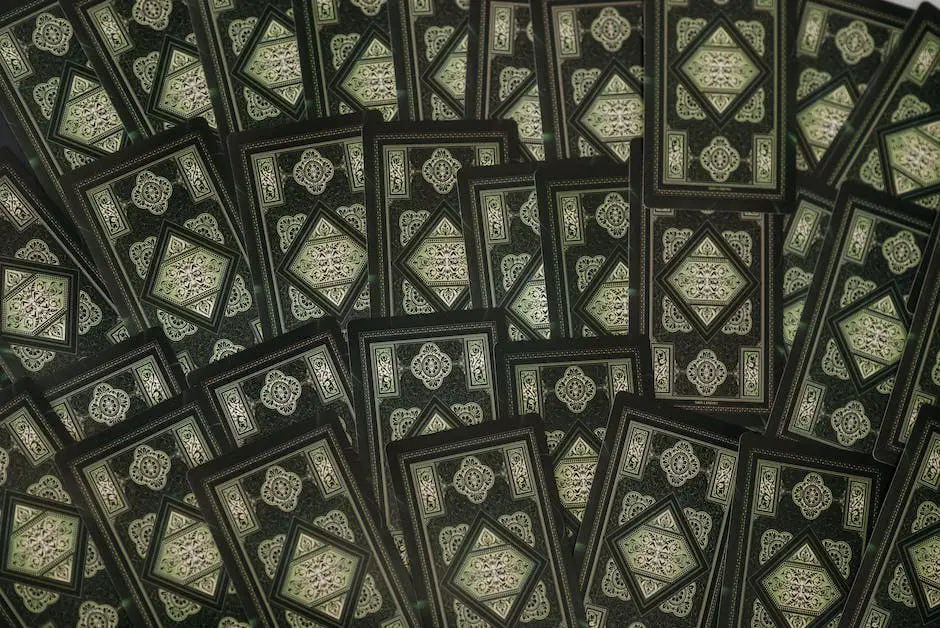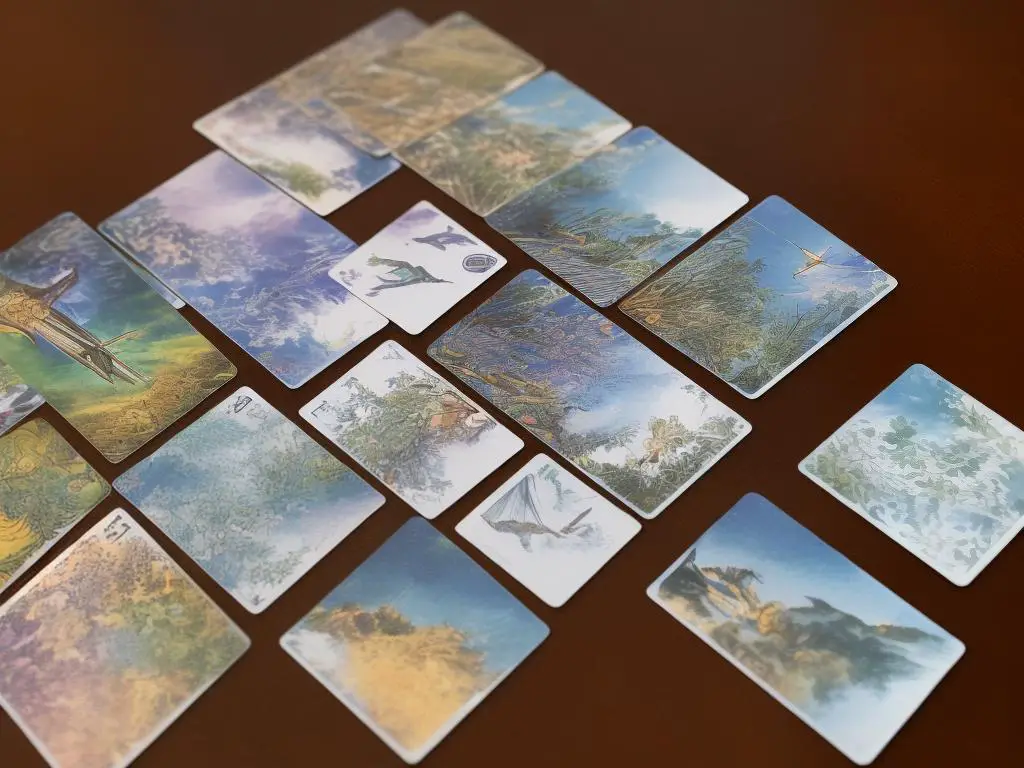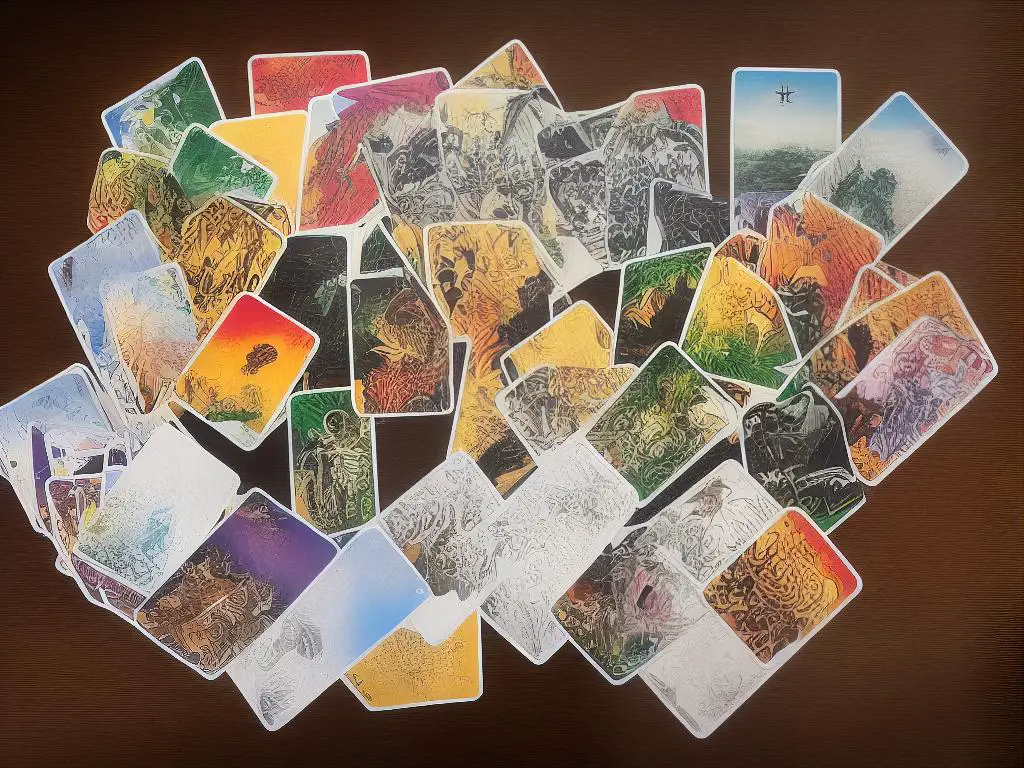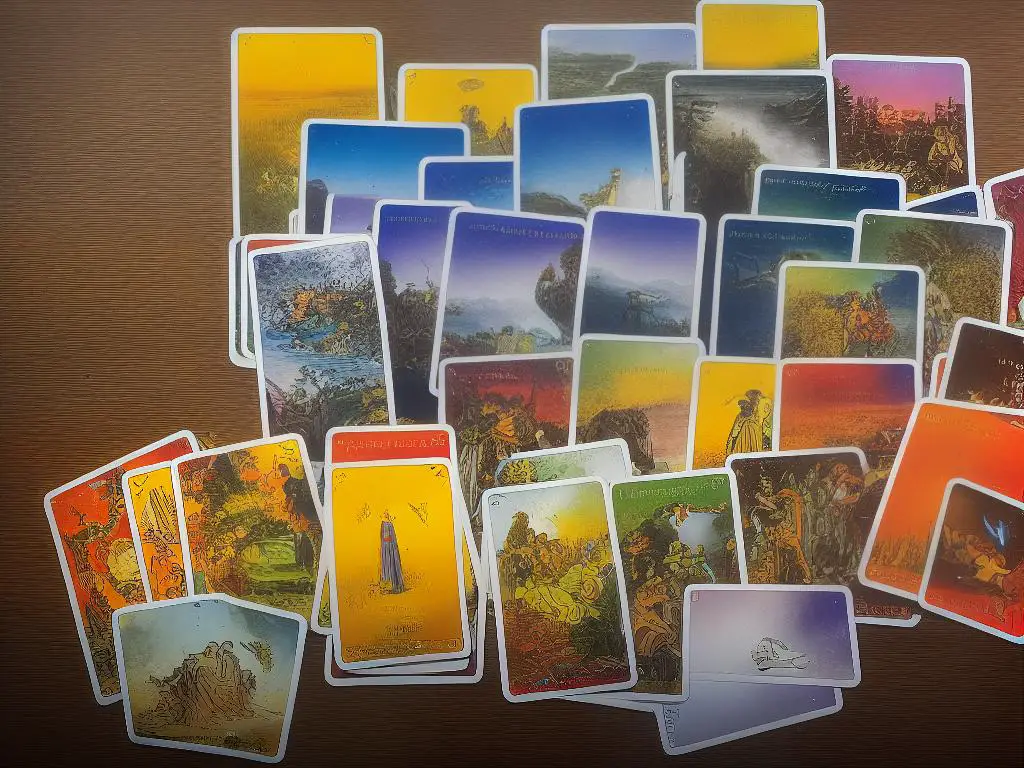Embark on a journey into the fascinating world of Tarot card games, where mystique and strategy intertwine. Discover the history, rules, and variations of these intriguing games rooted in Renaissance Europe, as well as the unique symbolism of the Tarot cards themselves. From understanding the significance of the Major and Minor Arcana, to mastering the gameplay and etiquette, this comprehensive guide will equip you with the knowledge and skills to embark on your own Tarot card game adventure.
History of Tarot Card Games
A Brief History of Tarot Card Games: From Renaissance Europe to Modern Interpretations & Variations
Tarot card games have a long and fascinating history, dating back to the Renaissance era in Europe. Over the years, they have evolved significantly, giving rise to a myriad of different games and interpretations. In this article, we will explore the origins and evolution of Tarot card games, from their early beginnings as Tarocchi in Italy to their contemporary forms and variations.
The Origins of Tarot Card Games: Tarocchi in Renaissance Italy
The first tarot cards can be traced back to Italy in the 1430s, where they were known as “carte da trionfi” or triumph cards. These early decks featured symbols and images from medieval allegories and religious iconography, and were used to play a trick-taking card game called Tarocchi. Players would use these cards to take turns trying to predict the outcome of a set of events, and the winner was determined by the highest number of “triumphs” or points.
The Spread of Tarot Card Games across Europe
By the 1500s, Tarocchi had become popular in different parts of Europe, such as France and Switzerland. During this time, the original triumph cards evolved into what we know today as the Major Arcana, a set of 22 cards that make up the spiritual and mystical basis of tarot decks. The remaining cards, known as the Minor Arcana, consist of 56 cards divided into four suits: Cups, Swords, Wands, and Pentacles.
Tarot Card Games in the Modern Era
In the 18th and 19th centuries, Tarot card games became increasingly popular and widespread. During this time, occultists and mystics, such as Antoine Court de Gébelin and Etteilla, began interpreting Tarot cards for divination and fortune-telling purposes. This led to the emergence of Hermetic and esoteric Tarot decks, which were specifically designed for spiritual guidance and self-reflection.
Learning to Play Tarot Card Games
Given the diverse range of Tarot decks and game variations available, there is no single set of rules that apply to all Tarot card games. However, many tarot games share similar gameplay elements, such as trick-taking, bidding, and trumping. To learn how to play a particular Tarot card game, it’s essential to familiarize yourself with the specific deck, rules, and objectives of that game.
The history of Tarot card games is a fascinating journey through time, culture, and spiritual beliefs. From the early Tarocchi games of Renaissance Italy to the diverse and creative Tarot games of today, Tarot cards have provided countless hours of entertainment and inspiration to players around the world. As you explore the rich history and traditions of Tarot card games, you can join in this enduring legacy and discover the unique qualities and insights that each deck has to offer.

Understanding Tarot Cards and Suits: A Guide for the General Public
Tarot cards have been used for centuries for various purposes such as divination, self-reflection, and even as a fun and engaging card game. In order to effectively utilize tarot cards and understand the intricate symbolism behind them, it’s essential to familiarize yourself with their structure and meaning. This guide will help you understand the basics of tarot cards and suits.
The Tarot Deck Structure
A standard tarot deck is made up of 78 cards, which are divided into two categories: the Major Arcana and Minor Arcana.
The Major Arcana
The Major Arcana consists of 22 cards, numbered from 0 to 21. Each card represents a significant life event or spiritual lesson, often reflecting the journey of the soul. The Fool, numbered as 0, is the main character in this journey and goes through various experiences, which are represented by the other 21 cards.
Familiarize yourself with the names and meanings of each Major Arcana card, as they provide insights into life’s challenges and guidance for personal growth. Some of the most well-known cards include:
- The Fool: Represents new beginnings, spontaneity, and taking risks
- The Magician: Symbolizes manifestation, willpower, and creativity
- The High Priestess: Represents intuition, mystery, and the subconscious mind
- The Empress: Symbolizes nurturing, abundance, and fertility
- The Emperor: Represents authority, stability, and discipline
The Minor Arcana and Suits
The Minor Arcana consists of 56 cards, divided into four suits: Cups, Pentacles, Swords, and Wands. These cards represent the more mundane aspects of life, such as relationships, emotions, thoughts, and material possessions. Each suit has its own unique qualities and symbolism:
- Cups: This suit is associated with the element of water and represents emotions, intuition, and relationships. The suit of Cups is often related to love, feelings, and creativity.
- Pentacles: Associated with the element of earth, the suit of Pentacles represents material aspects of life, such as money, possessions, and career. This suit can also signify issues related to security and stability.
- Swords: Linked to the element of air, the Swords suit represents thoughts, intellect, and communication. These cards often deal with conflict, decisions, and mental challenges.
- Wands: Representing the element of fire, the suit of Wands symbolizes passion, action, and energy. This suit is often related to personal growth, ambition, and creative endeavors.
Each suit contains ten numbered cards (ace through ten), and four court cards: Page, Knight, Queen, and King. The numbered cards represent different situations or experiences, while the court cards usually represent people or specific personality traits.
To familiarize yourself with the Minor Arcana and suits, study the meaning and symbolism of each card. An understanding of the cards will help you interpret them accurately and gain insight into various aspects of your life or the lives of others.
Understanding Tarot Cards
Understanding tarot cards and their suits requires dedication and a willingness to learn the symbolism and meaning behind each card. By familiarizing yourself with the Major Arcana, Minor Arcana, and the four suits, you will be well on your way to appreciating the wisdom and guidance that tarot cards can offer. Whether you use them for personal insight or as a tool for connecting with others, tarot cards can be a fascinating and enriching aspect of your life.

Basic Tarot Card Game Rules
Basic Tarot Card Game Rules
Tarot card games have been played for centuries and involve a unique blend of strategy, skill, and luck. In this guide, you will learn the fundamentals of Tarot card game rules, including card hierarchy, winning hands, game variations, and gameplay. By the end of this article, you should have a good understanding of how to play a basic tarot card game with friends or family.
1. Card Hierarchy
Tarot decks consist of 78 cards, with 56 of these cards called the Minor Arcana and the remaining 22 cards called the Major Arcana or trump cards. The Minor Arcana cards are divided into four suits: Cups, Swords, Coins (or Pentacles), and Wands (or Batons). Each suit contains ten numbered cards (Ace through 10) and four court cards (King, Queen, Knight, and Page).
In tarot card game, the card hierarchy is as follows:
- Trumps (Major Arcana): The Fool, followed by Trumps 1-21, with 21 being the highest and 1 the lowest.
- Minor Arcana (in each suit): King, Queen, Knight, Page, 10, 9, 8, 7, 6, 5, 4, 3, 2, Ace.
2. Winning Hands
There are several types of winning hands in tarot card games, and some of these include:
- Singletons: Cards that stand alone within a suit
- Sequences: Groups of three or more cards in consecutive order
- Pairs: Two cards of the same rank
- Triplets: Three cards of the same rank
- Flushes: Five or more cards of the same suit
3. Game Variations
There are many variations of tarot card games, so it’s essential to decide on a specific version to play with your friends or family. Some popular tarot card game variations include French Tarot, Italian Tarocchini, and Austrian Königrufen.
4. Choosing a trump suit
At the beginning of a tarot card game, a player (often the dealer) randomly selects a trump suit, which outranks all other suits throughout the game. Trump suit cards rank in the order of the Major Arcana hierarchy, followed by the King, Queen, Knight, Page, and numbered cards in the selected suit.
5. Gameplay
A basic tarot card game round proceeds as follows:
- Shuffle and deal: The dealer shuffles the deck and deals a set number of cards to each player. The remaining undealt cards (the stock) are placed face down in the center of the table.
- Bidding: After examining their cards, each player submits a bid (the number of tricks they believe they can win) in clockwise order, starting with the player to the dealer’s left. The player with the highest bid becomes the “declarer” and plays the lead card in the first trick.
- Play: Starting with the lead card played by the declarer, players take turns playing a card from their hand, following the suit, if possible. If a player cannot follow suit, they may play any card, including a trump card. The highest trump card or the highest card of the suit led wins the trick.
- Scoring: Scoring occurs based on the cards captured during the game, and typically, each trump card has a point value, as do the Kings, Queens, Knights, and Pages.
Conclusion
By understanding these fundamental tarot card game rules, you should now be able to enjoy a round of tarot with your friends or family. Remember that practice makes perfect, so it may take a few games to become truly proficient. Happy playing!
Tarot Card Game Etiquette
Introduction:
Tarot card games have been around for centuries, and are a popular choice for gatherings or just a quiet evening with friends. To create a fun and engaging game experience for everyone involved, it’s essential to understand the proper etiquette when playing. This guide will walk you through the do’s and don’ts of Tarot card game etiquette, so you can become a courteous and respectful player.
1. Shuffling and Dealing the Cards:
- Do: Ask the owner of the deck for permission to shuffle and deal the cards. Some players may have personal preferences or traditions they would like to observe.
- Do: Shuffle the deck thoroughly and cut the cards in a respectful manner, avoiding bending or damaging the cards.
- Don’t: Shuffle the cards carelessly or aggressively, as this could damage the cards or upset the owner of the deck.
- Do: Deal the cards according to the game’s rules and ensure each player has the correct number of cards.
2. Giving Hints and Strategic Gameplay:
- Do: Communicate with your partner or teammates clearly, following the game’s rules for giving hints or suggestions.
- Don’t: Give unsolicited advice to other players or attempt to control their moves, as this can be frustrating and impede their enjoyment of the game.
- Do: Consider each move carefully, and weigh the potential risks and rewards before playing a card.
- Don’t: Stall or take an excessive amount of time to play a card, as this can slow down the game and is considered poor etiquette.
3. Handling the Tarot Cards:
- Do: Treat the cards with care and respect.
- Don’t: Touch other players’ cards without their permission. This is particularly important in games that involve hidden information or strategy.
- Do: Keep your cards organized and in good condition, as this shows respect for the game and the other players.
4. Observing Good Sportsmanship:
- Do: Be gracious in both victory and defeat. Congratulate your opponents on a well-played game, and remain humble when you’ve emerged victorious.
- Don’t: Gloat or criticize other players’ gameplay during or after the game, as this can create a negative atmosphere for all involved.
- Do: Be patient with new players or those who may not be familiar with the rules and conventions of the game.
- Don’t: Use manipulation or dishonest tactics to gain an advantage over other players.
5. Ensuring a Fun and Inclusive Atmosphere:
- Do: Be considerate of all players’ sensitivities or beliefs surrounding Tarot cards, as some people may have spiritual or personal associations with the cards.
- Don’t: Discuss controversial or offensive topics during gameplay, as this can create an uncomfortable atmosphere for some players.
- Do: Encourage a welcoming and inclusive environment for all players, regardless of their skill level or experience with Tarot card games.
- Don’t: Exclude or ridicule players based on their lack of knowledge or skill, as this can discourage them from participating in the future.
Conclusion:
Tarot card games can be a fun and enriching experience when good etiquette is observed. By following these do’s and don’ts, you’ll help create a positive and enjoyable atmosphere for everyone involved. Happy gaming!

Popular Tarot Card Game Variations
Tarot card games: Much more than divination
Tarot card games have been enjoyed for centuries in various parts of the world. While the Tarot deck is often associated with fortune-telling and divination, it was initially created for playing card games. Here are some popular Tarot card game variations and how to play them:
1. French Tarot (Tarot Nouveau)
French Tarot is a trick-taking game played by 3-5 players using a Tarot deck containing 78 cards: 56 suited cards and 22 trumps. The cards are divided into four suits: spades, clubs, diamonds, and hearts, and they are ranked from Ace to 10, followed by the “court” cards: Valet (Jack), Knight, Queen, and King.
To play the game:
- A. Shuffle the Tarot deck and deal each player a specific number of cards, depending on the number of players (e.g., 24 cards for three players, 18 cards for four).
- B. Form a stock by placing the remaining cards (also called the “chien” or “dog”) face down in the center.
- C. The bidding phase begins, where the players decide whether to pass or take the risk and attempt to win a majority of points during the round.
- D. The player who wins the bidding phase (called the “taker”) picks up the chien and adds all or some to their hand. The player must then balance their hand by discarding the same number of cards. Trump cards and Kings cannot be discarded.
- E. Play proceeds clockwise, with each player being required to follow suit if possible, otherwise playing a trump card. The player who played the highest-ranked card of the leading suit or a trump card wins the trick.
- F. After the final trick, players calculate their scores by counting the point value of the cards they won in their tricks. The goal is for the taker to win more points than the predetermined threshold, which depends on the number of cards in the chien.
2. Italian Tarocchi (Scopone Tarocchi or Mitigati)
Italian Tarocchi is a 2-5 player game, where the Tarot deck usually consists of 62 or 78 cards. The game has similarities to French Tarot, but with minor differences in rules and gameplay.
To play the game:
- A. Shuffle and deal the entire deck amongst the players. If playing with 78 cards, you’ll have 3-4 players. If playing with 62, it’s often a 5-player game.
- B. Play proceeds clockwise, with each player contributing one card to the trick. Players must follow suit if possible. If they can’t follow suit, they should play a trump card or from another suit.
- C. The player who played the highest-ranked trump card or the highest card of the leading suit wins the trick, and the winner leads the next trick.
- D. After all cards have been played, players count points based on their taken tricks. There is no bidding phase in this variation, and only the cards won in tricks count towards a player’s score.
3. Austrian Tarock
Austrian Tarock is a three-player game with various sub-variations, the most famous of which is Königrufen. The deck used in Austrian Tarock has 54 Tarot cards.
To play the game (Königrufen variant):
- A. Shuffle the deck and deal each player 16 cards, then place 6 cards in the center as the talon (similar to the chien in French Tarot).
- B. Conduct a bidding phase where players can call “Königrufen,” indicating they are willing to undertake specific contracts (differing in difficulty and the number of points available to win).
- C. The winner of the bidding phase (called the declarer) chooses a contract, picks up the talon, discards the same number of cards, and may announce bonuses (achieving specific card combinations).
- D. Play proceeds clockwise. Players must follow suit and, if possible, play a card of higher rank than the current highest card in the trick. If they can’t follow suit, they should play a trump card.
- E. After all tricks have been played, the declarer must have won a minimum number of points to achieve their called contract. Points are calculated from the cards won in tricks and the bonuses announced.
Diverse Tarot card games around the world
These are just a few examples of the diverse Tarot card games played around the world. Each of these games has its unique strategies and techniques, providing a rich and varied experience for players. Enjoy exploring these Tarot card game variations and see which ones become your favourites!

Strategies and Tips for Winning Tarot Card Games
Introduction:
Tarot card games are fun and challenging for players of all skill levels. In order to consistently win games, it’s essential to develop effective strategies and learn how to make the best possible decisions throughout the game. In this guide, we’ll provide you with tips and strategies for choosing the right trump suit, making tactical bids, and playing your cards optimally to increase your chances of winning.
1. Getting Familiar with the Tarot Deck:
Before embarking on your tarot card gaming journey, it’s essential to become familiar with the tarot deck. A tarot deck comprises 78 cards, which consist of four suits of 14 cards each (cups, coins, swords, and wands) and 21 trump cards, numbered from I to XXI, and the Fool, which is unnumbered. Understanding the structure and significance of the cards is crucial for effective gameplay.
2. Choosing the Trump Suit:
- Look for the suit with the highest number of high-ranking cards (e.g., kings, queens, and knights).
- Consider your hand’s balance between trumps and other suits. Aim to have a mix that allows flexibility during gameplay.
- Opt for a suit that complements your partner’s hand (if playing a partnership game) to maximize your team’s overall strength.
3. Bidding Strategically:
- Bid aggressively if you have a strong hand, with numerous high-ranking cards and a good mix of suits.
- Pay attention to your opponents’ bids to gauge their hand strength and adjust your strategy accordingly.
- Consider the benefits and risks of each bid level. Sometimes, it might be worth taking a higher risk to secure the trump suit or to prevent an opponent from doing so.
4. Winning Tricks:
- Play high-ranking cards from the trump suit, particularly when you’re confident that no higher cards will be played in that trick.
- Conserve high-ranking non-trump cards for situations where they have the best chance of winning a trick, such as when the trump suit has already been played or when the trump suit is unlikely to be played.
- Utilize lower-ranking cards to force opponents to use their high-ranking cards, making them more vulnerable later in the game.
5. Effective Communication:
In partnership tarot card games, good communication with your partner can enhance your chances of winning. Develop a system to signal the strength of your hand and your intentions without revealing any specific information to your opponents.
6. Observing Your Opponents:
Paying close attention to your opponents can provide valuable insights into their strategies, hand strength, and potential moves. This information can help you adapt your strategy and make better decisions throughout the game.
7. Practice Consistently:
Like any game, mastering tarot card games requires practice. Regularly playing the game will help you develop essential skills, such as identifying patterns and adapting your strategy to the unique circumstances of each game.
Conclusion:
Developing a strong understanding of tarot card games and employing these strategies and tips will help you improve your gameplay and maximize your chances of winning. Remember, practice makes perfect, so invest the time to refine your skills and enjoy the exciting and competitive world of tarot card gaming.

Tarot Card Game Resources and Communities
Tarot card games are a fascinating combination of skills, strategy, and intuition, providing a unique and engaging gaming experience. As a fan of tarot card games, it’s always fun and rewarding to connect with fellow enthusiasts, learn from one another, and explore new resources. This guide will provide instructions on finding resources and communities dedicated to the love of tarot card games, so you can expand your knowledge and connect with like-minded individuals.
Utilize Online Search Engines:
To find Tarot card game resources and communities, start by conducting a simple web search using keywords such as “Tarot card game forums,” “Tarot card game communities,” “Tarot card game groups,” or “learn Tarot card games.” Browse through the search results to find websites, forums, and online communities that align with your interests.
Explore Social Media Platforms:
Social media platforms, such as Facebook, Twitter, and Instagram, are great places to find Tarot card game enthusiasts. Search for popular tarot-related hashtags (#tarot, #tarotcardgames, #tarotcommunity) or use the platform’s search bar to find groups and pages related to tarot card games. Join these groups to connect with fellow players, ask questions, share tips, and learn about new resources.
Join Online Forums:
Online forums and message boards provide an excellent platform for connecting with other Tarot card game players. Websites such as Reddit, Aeclectic Tarot Forum, and Tarotforum.net offer dedicated sections for tarot card games. Sign up for an account, introduce yourself, and start participating in discussions to learn from others and share your own knowledge and experiences.
Discover Blogs and Websites:
There are numerous blogs and websites out there that focus on tarot card games. These resources often provide card interpretations, playing tips, and information about various tarot decks. Some popular tarot blogs and websites include The Tarot School, Biddy Tarot, and Little Red Tarot. Bookmark these sites, subscribe to their newsletters, or follow them on social media to stay updated on their content.
Subscribe to YouTube Channels:
Many Tarot card game enthusiasts share their knowledge, tips, and experiences through YouTube. Some channels focus on teaching tarot card games while others offer reviews of different tarot decks or discuss tarot history and symbolism. Subscribe to channels that interest you and engage with the content creators through comments and likes.
Attend Tarot Meetups & Events:
Search for local tarot card game meetups and events in your area through websites like Meetup.com. These gatherings provide an excellent opportunity to connect with other Tarot enthusiasts, learn new techniques, and play tarot card games in a social setting.
Consider Taking Online Courses or Workshops:
Expand your Tarot card game knowledge by enrolling in online courses or workshops. Websites such as Udemy, Coursera, and Skillshare offer classes on various tarot-related topics, including tarot card games. By learning from experienced instructors, you can improve your skills and become a better Tarot card game player.
Engage in Tarot Card Game Challenges:
Look for Tarot card game challenges on forums, social media groups, or blogs that you can participate in. These challenges can be a fun way to test your skills, learn from others, and expand your knowledge of different Tarot card game variations.
Conclusion:
By exploring various resources and joining online communities, you’ll connect with fellow tarot card game enthusiasts and expand your knowledge of this captivating pastime. Don’t be shy to ask questions and share your experiences, as learning from one another is a crucial aspect of being part of a community. Enjoy the journey as you delve deeper into the world of tarot card games.

Now that you’re equipped with a wealth of knowledge about Tarot card games, it’s time to put your skills to the test. Experiment with the various game variations, apply the strategies and tips you’ve learned, and connect with fellow enthusiasts in online communities. As you explore the captivating world of Tarot card games, you’ll not only enjoy hours of entertainment but also hone your strategic thinking, all while delving into the rich history and symbolism of this timeless art. The cards are in your hands; play them wisely and embrace the Tarot experience.
FAQ-Tarot Cards
A: This guide is designed to help individuals enhance their tarot card game skills and knowledge.
A: Beginners can learn the rules, card meanings, and strategies necessary to start playing tarot card games confidently.
A: Yes, this guide explores popular tarot card games such as Tarocchini, Tarot Nouveau, and French Tarot, providing insights and tips for each.
A: Absolutely! Experienced players can discover advanced strategies, game variations, and deepen their understanding of tarot card games.
A: Yes, this guide offers clear and easy-to-follow instructions to help players grasp the fundamentals and improve their gameplay.
A: This guide provides explanations and interpretations of tarot card meanings, allowing players to develop a deeper connection with the cards.
A: Yes, readers can find practical tips and advice to overcome common challenges like decision-making, interpreting complex spreads, and more.
A: Yes, various strategic approaches and tactics are discussed to increase players’ chances of winning in tarot card games.
A: Absolutely! This guide covers a wide range of topics, including the history of tarot cards, symbolism, and methods of reading and interpreting the cards.
For more exciting card games, check out this page here!